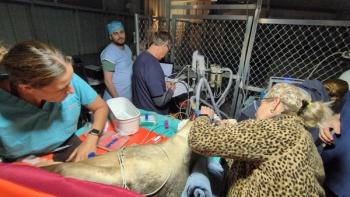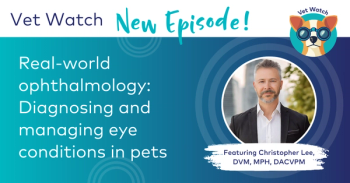
Practical Matters: Topical atropine: An overused medication
Atropine is a strong parasympathetic blocking agent. When applied topically, it causes pupillary dilatation that may last several days. Topical atropine should be administered only when this degree of pupillary dilatation is desired, which is not often.
Atropine is a strong parasympathetic blocking agent. When applied topically, it causes pupillary dilatation that may last several days. Topical atropine should be administered only when this degree of pupillary dilatation is desired, which is not often.
Contrary to what many of us were taught in veterinary school, atropine appears to be of little value in pain relief in the treatment of most superficial corneal ulcers. Intraocular inflammation (uveitis) may be associated with painful ciliary spasm, clinically identified because of the associated miosis. Most superficial corneal ulcers have minimal secondary uveitis and do not exhibit miosis. The mydriasis and cycloplegia caused by atropine would not be expected to provide pain relief in the absence of miosis. Pain associated with superficial corneal ulcers is caused by direct stimulation of damaged and exposed corneal nerves rather than by secondary uveitis. Atropine has no topical anesthetic effect, yet it is often administered for pain relief in patients with superficial corneal ulcers. Disadvantages of topical atropine include prolonged pupillary dilatation, photophobia, an inability to assess direct pupillary light responses, and the potential to increase intraocular pressure, particularly if the pressure is already elevated.
Good alternatives to topical atropine are available and should be selected based on the effect desired. Tropicamide 1% causes a similar parasympathetic blockade that only lasts three or four hours. It is not as strong a mydriatic and must be applied more often than atropine to maintain pupillary dilatation. Although also not a strong mydriatic, phenylephrine 2.5% is a sympathomimetic agent that when used in combination with tropicamide can dilate the pupils for diagnostic or therapeutic purposes. In cases of pupillary adhesions (posterior synechia), mechanically breaking the adhesions by pharmacologic means is often ineffective. Tropicamide-induced mydriasis encourages a mobile pupil because its effect wears off more quickly than atropine's effect. This is advantageous in eyes with inflammation, as adhesions can reform with the pupil fixed in a dilated position.
In summary, I use topical atropine rarely and often see it used inappropriately, occasionally to deleterious effect. Consider using tropicamide instead.
Cynthia S. Cook, DVM, PhD, DACVO
Veterinary Vision Animal Eye Specialists
219 N. Amphlett Blvd.
San Mateo, CA 94401
Newsletter
From exam room tips to practice management insights, get trusted veterinary news delivered straight to your inbox—subscribe to dvm360.






